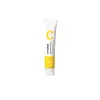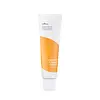What's inside
What's inside
 Key Ingredients
Key Ingredients

 Benefits
Benefits

 Concerns
Concerns

 Ingredients Side-by-side
Ingredients Side-by-side

Water
Skin ConditioningGlycerin
HumectantButylene Glycol
HumectantDimethicone
EmollientCyclopentasiloxane
EmollientCetearyl Alcohol
Emollient1,2-Hexanediol
Skin ConditioningNiacinamide
SmoothingCaprylic/Capric Triglyceride
MaskingBehenyl Alcohol
EmollientPanthenol
Skin ConditioningDimethicone/Vinyl Dimethicone Crosspolymer
Skin ConditioningPEG-40 Stearate
EmulsifyingGlyceryl Stearate
EmollientMannitol
HumectantSqualane
EmollientCeramide NP
Skin ConditioningHydrogenated Lecithin
EmulsifyingStearyl Alcohol
EmollientArachidyl Alcohol
EmollientArginine
MaskingMicrocrystalline Cellulose
AbsorbentAcrylates/C10-30 Alkyl Acrylate Crosspolymer
Emulsion StabilisingCitrus Aurantium Dulcis Peel Oil
MaskingZea Mays Starch
AbsorbentEthylhexylglycerin
Skin ConditioningDipotassium Glycyrrhizate
HumectantSynthetic Fluorphlogopite
Adenosine
Skin ConditioningDisodium EDTA
Ascorbic Acid
AntioxidantAscorbyl Palmitate
AntioxidantCI 77492
Cosmetic ColorantEthylcellulose
Hippophae Rhamnoides Water
MaskingSalicylic Acid
MaskingSodium Hyaluronate
HumectantGluconolactone
Skin ConditioningCitric Acid
BufferingCamellia Sinensis Leaf Extract
AntimicrobialLavandula Angustifolia Flower Extract
CleansingFreesia Refracta Extract
Skin ConditioningMentha Piperita Leaf Extract
Skin ConditioningChamomilla Recutita Flower Extract
MaskingMonarda Didyma Leaf Extract
Skin ConditioningRosmarinus Officinalis Leaf Extract
AntimicrobialCoffea Arabica Seed Extract
MaskingPyrus Malus Fruit Extract
Skin ConditioningCentella Asiatica Extract
CleansingLimonene
PerfumingWater, Glycerin, Butylene Glycol, Dimethicone, Cyclopentasiloxane, Cetearyl Alcohol, 1,2-Hexanediol, Niacinamide, Caprylic/Capric Triglyceride, Behenyl Alcohol, Panthenol, Dimethicone/Vinyl Dimethicone Crosspolymer, PEG-40 Stearate, Glyceryl Stearate, Mannitol, Squalane, Ceramide NP, Hydrogenated Lecithin, Stearyl Alcohol, Arachidyl Alcohol, Arginine, Microcrystalline Cellulose, Acrylates/C10-30 Alkyl Acrylate Crosspolymer, Citrus Aurantium Dulcis Peel Oil, Zea Mays Starch, Ethylhexylglycerin, Dipotassium Glycyrrhizate, Synthetic Fluorphlogopite, Adenosine, Disodium EDTA, Ascorbic Acid, Ascorbyl Palmitate, CI 77492, Ethylcellulose, Hippophae Rhamnoides Water, Salicylic Acid, Sodium Hyaluronate, Gluconolactone, Citric Acid, Camellia Sinensis Leaf Extract, Lavandula Angustifolia Flower Extract, Freesia Refracta Extract, Mentha Piperita Leaf Extract, Chamomilla Recutita Flower Extract, Monarda Didyma Leaf Extract, Rosmarinus Officinalis Leaf Extract, Coffea Arabica Seed Extract, Pyrus Malus Fruit Extract, Centella Asiatica Extract, Limonene
Hippophae Rhamnoides Fruit Extract
Skin ConditioningButylene Glycol
HumectantPentylene Glycol
Skin ConditioningWater
Skin Conditioning1,2-Hexanediol
Skin ConditioningNiacinamide
SmoothingEthylhexyl Palmitate
EmollientCaprylic/Capric Triglyceride
MaskingMoringa Oleifera Seed Oil
EmollientLycium Barbarum Fruit Extract
AstringentEuterpe Oleracea Fruit Extract
Myrciaria Dubia Fruit Extract
Skin ConditioningHippophae Rhamnoides Oil
EmollientBeta-Glucan
Skin ConditioningOlea Europaea Fruit Oil
MaskingCarthamus Tinctorius Seed Oil
MaskingPhytosphingosine
Skin ConditioningPolyacrylic Acid
Emulsion StabilisingCyanocobalamin
Skin ConditioningSodium Ascorbyl Phosphate
AntioxidantBiotin
AntiseborrhoeicPyridoxine
Skin ConditioningGlyceryl Arachidonate
EmollientMangifera Indica Seed Butter
Skin ConditioningSodium Acrylate/Sodium Acryloyldimethyl Taurate Copolymer
Emulsion StabilisingIsohexadecane
EmollientCeramide NP
Skin ConditioningArgania Spinosa Kernel Oil
EmollientMacadamia Ternifolia Seed Oil
EmollientPolyglyceryl-10 Stearate
Skin ConditioningHydroxypropyl Guar
Emulsion StabilisingPanthenol
Skin ConditioningCarbomer
Emulsion StabilisingGlyceryl Acrylate/Acrylic Acid Copolymer
HumectantArginine
MaskingSucrose Distearate
EmollientPvm/Ma Copolymer
Emulsion StabilisingDisodium EDTA
Glycerin
HumectantThiamine Hcl
MaskingHydrogenated Lecithin
EmulsifyingTocopheryl Acetate
AntioxidantGlyceryl Linolenate
EmollientPolysorbate 80
EmulsifyingEthyl Hexanediol
SolventRetinyl Palmitate
Skin ConditioningHippophae Rhamnoides Fruit Extract, Butylene Glycol, Pentylene Glycol, Water, 1,2-Hexanediol, Niacinamide, Ethylhexyl Palmitate, Caprylic/Capric Triglyceride, Moringa Oleifera Seed Oil, Lycium Barbarum Fruit Extract, Euterpe Oleracea Fruit Extract, Myrciaria Dubia Fruit Extract, Hippophae Rhamnoides Oil, Beta-Glucan, Olea Europaea Fruit Oil, Carthamus Tinctorius Seed Oil, Phytosphingosine, Polyacrylic Acid, Cyanocobalamin, Sodium Ascorbyl Phosphate, Biotin, Pyridoxine, Glyceryl Arachidonate, Mangifera Indica Seed Butter, Sodium Acrylate/Sodium Acryloyldimethyl Taurate Copolymer, Isohexadecane, Ceramide NP, Argania Spinosa Kernel Oil, Macadamia Ternifolia Seed Oil, Polyglyceryl-10 Stearate, Hydroxypropyl Guar, Panthenol, Carbomer, Glyceryl Acrylate/Acrylic Acid Copolymer, Arginine, Sucrose Distearate, Pvm/Ma Copolymer, Disodium EDTA, Glycerin, Thiamine Hcl, Hydrogenated Lecithin, Tocopheryl Acetate, Glyceryl Linolenate, Polysorbate 80, Ethyl Hexanediol, Retinyl Palmitate
Ingredients Explained
These ingredients are found in both products.
Ingredients higher up in an ingredient list are typically present in a larger amount.
1,2-Hexanediol is a synthetic liquid and another multi-functional powerhouse.
It is a:
- Humectant, drawing moisture into the skin
- Emollient, helping to soften skin
- Solvent, dispersing and stabilizing formulas
- Preservative booster, enhancing the antimicrobial activity of other preservatives
Arginine is an amino acid that is important for human development. Your body uses is it to produce hair keratin and skin collagen.
As a cosmetic ingredient, Arginine has antioxidant properties and can also help repair damaged skin. This ingredient is derived either synthetically or from animals.
Arginine isn't fungal acne safe when used in the presence of other lipids (fats, fatty acids, oils, esters, etc). Oils and fats occur naturally within the skin, so take caution when using Arginine if you're prone to fungal acne.
Learn more about ArginineButylene Glycol (or BG) is used within cosmetic products for a few different reasons:
Overall, Butylene Glycol is a safe and well-rounded ingredient that works well with other ingredients.
Though this ingredient works well with most skin types, some people with sensitive skin may experience a reaction such as allergic rashes, closed comedones, or itchiness.
Learn more about Butylene GlycolThis ingredient is an emollient, solvent, and texture enhancer. It is considered a skin-softener by helping the skin prevent moisture loss.
It helps thicken a product's formula and makes it easier to spread by dissolving clumping compounds.
Caprylic Triglyceride is made by combining glycerin with coconut oil, forming a clear liquid.
While there is an assumption Caprylic Triglyceride can clog pores due to it being derived from coconut oil, there is no research supporting this.
Learn more about Caprylic/Capric TriglycerideCeramide NP is a type of ceramide and formally known as ceramide 3.
Ceramides are intercellular lipids naturally found in our skin that bonds dead skin cells together to create a barrier. They are known for their ability to hold water and thus are a great ingredient for dry skin.
Ceramides are an important building block for our skin barrier. A stronger barrier helps the skin look more firm and hydrated. By bolstering the skin ceramides act as a barrier against irritating ingredients. This can help with inflammation as well.
If you would like to eat ceramides, sweet potatoes contain a small amount.
Read more about other common types of ceramides here:
Ceramide AP
Ceramide EOP
Disodium EDTA plays a role in making products more stable by aiding other preservatives.
It is a chelating agent, meaning it neutralizes metal ions that may be found in a product.
Disodium EDTA is a salt of edetic acid and is found to be safe in cosmetic ingredients.
Learn more about Disodium EDTAGlycerin is already naturally found in your skin. It helps moisturize and protect your skin.
A study from 2016 found glycerin to be more effective as a humectant than AHAs and hyaluronic acid.
As a humectant, it helps the skin stay hydrated by pulling moisture to your skin. The low molecular weight of glycerin allows it to pull moisture into the deeper layers of your skin.
Hydrated skin improves your skin barrier; Your skin barrier helps protect against irritants and bacteria.
Glycerin has also been found to have antimicrobial and antiviral properties. Due to these properties, glycerin is often used in wound and burn treatments.
In cosmetics, glycerin is usually derived from plants such as soybean or palm. However, it can also be sourced from animals, such as tallow or animal fat.
This ingredient is organic, colorless, odorless, and non-toxic.
Glycerin is the name for this ingredient in American English. British English uses Glycerol/Glycerine.
Learn more about GlycerinHydrogenated Lecithin is created from the hydrogenation of lecithin (a group of phospholipids). Hydrogenation is a chemical reaction between hydrogen and another element.
This ingredient is an emollient and emulsifier. As an emollient, it helps soften skin by trapping moisture within. As an emulsifier, it prevents oil and water ingredients from separating.
Niacinamide is a multitasking form of vitamin B3 that strengthens the skin barrier, reduces pores and dark spots, regulates oil, and improves signs of aging.
And the best part? It's gentle and well-tolerated by most skin types, including sensitive and reactive skin.
You might have heard of "niacin flush", or the reddening of skin that causes itchiness. Niacinamide has not been found to cause this.
In very rare cases, some individuals may not be able to tolerate niacinamide at all or experience an allergic reaction to it.
If you are experiencing flaking, irritation, and dryness with this ingredient, be sure to double check all your products as this ingredient can be found in all categories of skincare.
When incorporating niacinamide into your routine, look out for concentration amounts. Typically, 5% niacinamide provides benefits such as fading dark spots. However, if you have sensitive skin, it is better to begin with a smaller concentration.
When you apply niacinamide to your skin, your body converts it into nicotinamide adenine dinucleotide (NAD). NAD is an essential coenzyme that is already found in your cells as "fuel" and powers countless biological processes.
In your skin, NAD helps repair cell damage, produce new healthy cells, support collagen production, strengthen the skin barrier, and fight environmental stressors (like UV and pollution).
Our natural NAD levels start to decline with age, leading to slower skin repair, visible aging, and a weaker skin barrier. By providing your skin niacinamide, you're recharging your skin's NAD levels. This leads to stronger, healthier, and younger looking skin.
Another name for vitamin B3 is nicotinamide. This vitamin is water-soluble and our bodies don't store it. We obtain Vitamin B3 from either food or skincare. Meat, fish, wheat, yeast, and leafy greens contain vitamin B3.
The type of niacinamide used in skincare is synthetically created.
Learn more about NiacinamidePanthenol is a common ingredient that helps hydrate and soothe the skin. It is found naturally in our skin and hair.
There are two forms of panthenol: D and L.
D-panthenol is also known as dexpanthenol. Most cosmetics use dexpanthenol or a mixture of D and L-panthenol.
Panthenol is famous due to its ability to go deeper into the skin's layers. Using this ingredient has numerous pros (and no cons):
Like hyaluronic acid, panthenol is a humectant. Humectants are able to bind and hold large amounts of water to keep skin hydrated.
This ingredient works well for wound healing. It works by increasing tissue in the wound and helps close open wounds.
Once oxidized, panthenol converts to pantothenic acid. Panthothenic acid is found in all living cells.
This ingredient is also referred to as pro-vitamin B5.
Learn more about PanthenolWater. It's the most common cosmetic ingredient of all. You'll usually see it at the top of ingredient lists, meaning that it makes up the largest part of the product.
So why is it so popular? Water most often acts as a solvent - this means that it helps dissolve other ingredients into the formulation.
You'll also recognize water as that liquid we all need to stay alive. If you see this, drink a glass of water. Stay hydrated!
Learn more about Water